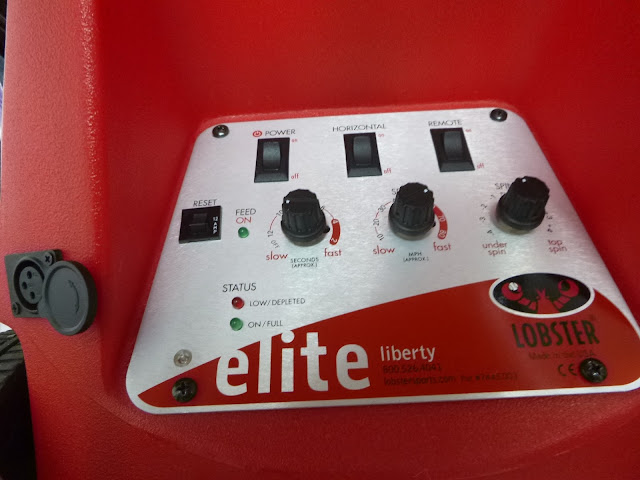Lobster Elite Liberty review
Here's the manufacturer's link to the product.
$949
Speed: 10 to 70 mph
Feed rate: 2-12 seconds
Spin: top, back
Elevation: manual, 0-50 degrees
Ball capacity: 150
Power: battery (ac/dc optional)
Court time: 2-4 hours
Basic charger: included
Fast charger: optional
Remote: optional
Weight: 35 lbs.
Warranty: 2 years
I bought this machine when I realized my tennis wasn't going to improve very quickly by dropping balls to myself or by hitting against a wall--the former leaves out the challenge/anxiety of hitting balls coming at me and the latter doesn't permit me to follow through with strokes. I certainly wasn't going to improve my volley without a machine or another player feeding me balls. My brother bought a Lobster Elite One $1139 and was very happy with it, paying the extra $169 for the remote, which I had initially ordered direct from the maker in California, but removed it from my order, when I decided it was overpriced for what it could do. Later, I found that ball machine owners with a DIY attitude installed their own remotes from transmitter/receiver kits bought from Amazon for $15-20. From what I could tell, the Liberty has most of what the Elite One has, for less $$.
I didn't buy the fast charger. Regular charging would be enough for an owner that wasn't going to teach tennis. The Lobster Elite Freedom $839 no longer appears on the website. The Freedom has no spin adjustment and doesn't weigh any less.
PROS:
1. capable
3. It's easy to lift to load into my car trunk, though it's a couple inches too tall to fit upright.
4. As far as I can tell, this has most of the capability of the Elite One for $190 less and weighs 7-8 lb. less, but still with enough time on the battery for most people.
5. The battery hasn't let me down yet, but I've yet to push it to four hours. Two hours on court is enough for me. With a remote, I'll be able to turn off after a load.
6. Without the remote, after powering on, the machine delays delivery for about 20 seconds to allow you to walk to the other side of the net.
7. It can shoot balls fast or slow; high or low and soft from baseline to baseline. Something I can grow into. Maybe I would have been OK with a lesser machine like a Slingerbag, or a refurbished Tennis Tutor unit.
8. Speed, angle, Topspin and back spin adjustments work well for this least expensive of the Lobster machines.
CONS:
1. expensive
2. A few screws holding the red body cover to the chassis were loose.
3. The release on the folding handle was finicky until I sprayed WD-40.
4. The long end of the interval between balls isn't 12 seconds; rather it's 7.6 seconds--not enough time for a shadow swing or two between balls. Maybe I have the odd machine. Tech support said: "well, you can tape off two of the four holes in the feeder tray." The challenge: blocking the holes so that there last balls don't just sit on the tape--maybe foam blocks with topsides shaped to keep balls moving to the active holes.
5. The remote is crazy expensive at $169 and it only controls the feeder and sweep functions--it won't turn off the whole machine. I bought a $15 Radio Frequency transmitter/receiver kit that I'll install when it arrives. I didn't find much on a search for tutorials on installation, but I'm pretty handy and have it figured out to control on/off, feeder motors and the sweep motor.
6. The path of the balls can vary by a few degrees. Expect it.
7. Up to five balls have remained in the hopper at the end, because of small design issues. I eliminated those nooks with foam and velcro.
8. If you try to push the Feed adjustment to deliver at a greater than 8 seconds, you'll risk having it stop feeding altogether. Lobster should have engineered a limit to prevent zero feeds.
Other things:
If the sweep interval matches the sweep cycle, you'll get many balls to the same area before moving to another area.
If it doesn't match, you can get more of a workout as you don't always know at what point of the sweep the next ball will fly.
Try to ensure your balls are the same brand, pressureless for longer play life, or you'll find balls bouncing inconsistently.
NO REGRETS ABOUT BUYING THIS. IT HAS HELPED ME IMPROVE MY GROUNDSTROKES AND VOLLEY. It has also helped me focus on watching ball contact, further improving my strokes.




No comments:
Post a Comment